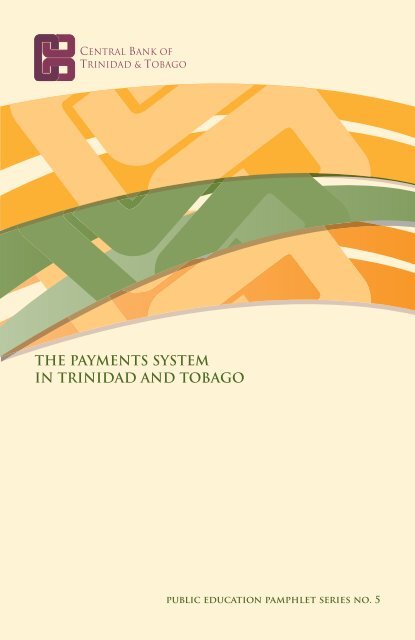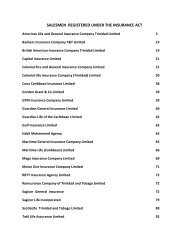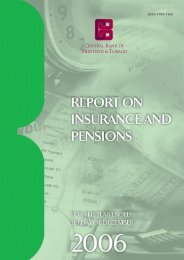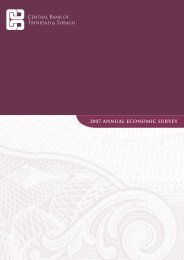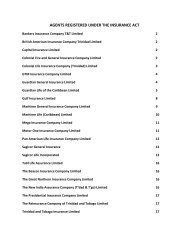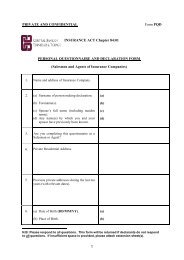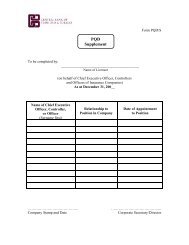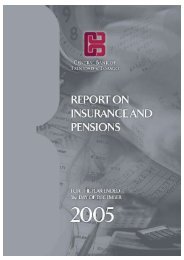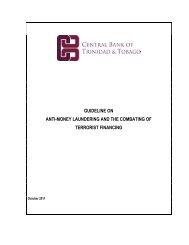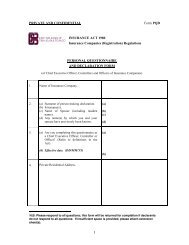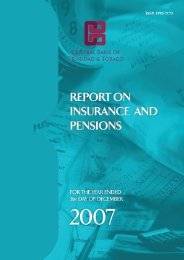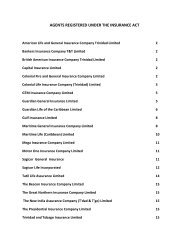the payments system in trinidad and tobago - Central Bank of ...
the payments system in trinidad and tobago - Central Bank of ...
the payments system in trinidad and tobago - Central Bank of ...
Create successful ePaper yourself
Turn your PDF publications into a flip-book with our unique Google optimized e-Paper software.
THE PAYMENTS SYSTEMIN TRINIDAD AND TOBAGOpublic education pamphlet series no. 5
public education pamphlet seriesISSN 1817-3160ACKNOWLEDGEMENTSThe <strong>Bank</strong> wishes to acknowledge <strong>the</strong> contributions <strong>of</strong>Mr. Osborne Nurse <strong>and</strong> Dr. Ronald Ramkissoon, whomade useful <strong>and</strong> valuable suggestions for thispublication.All rights reserved.No part <strong>of</strong> this publication may be reproduced <strong>in</strong> any form or o<strong>the</strong>rwise without<strong>the</strong> written permission <strong>of</strong> <strong>the</strong> <strong>Central</strong> <strong>Bank</strong> <strong>of</strong> Tr<strong>in</strong>idad <strong>and</strong> Tobago.ISBN:978-976-8134-12-7© <strong>Central</strong> <strong>Bank</strong> <strong>of</strong> Tr<strong>in</strong>idad <strong>and</strong> Tobago, October 2009
FOREWORDExternal communications are an important part <strong>of</strong> <strong>the</strong> bus<strong>in</strong>ess<strong>of</strong> <strong>the</strong> <strong>Central</strong> <strong>Bank</strong> <strong>of</strong> Tr<strong>in</strong>idad <strong>and</strong> Tobago. The <strong>Bank</strong>’s outreach<strong>in</strong>itiatives are <strong>in</strong>tended both to enhance its contribution to educat<strong>in</strong>g<strong>and</strong> <strong>in</strong>form<strong>in</strong>g <strong>the</strong> public generally, as well as to assist markets <strong>in</strong>underst<strong>and</strong><strong>in</strong>g <strong>the</strong> <strong>Bank</strong>’s policy actions <strong>and</strong> <strong>in</strong>tentions.In addition to <strong>the</strong> regular publications <strong>of</strong> its Research Department,<strong>the</strong> <strong>Bank</strong>’s Outreach Programme has <strong>in</strong>cluded lectures <strong>and</strong>speeches to school children by senior <strong>Bank</strong> <strong>of</strong>ficials, mentor<strong>in</strong>g toundergraduate students <strong>and</strong> support<strong>in</strong>g an <strong>in</strong>ternship arrangementwith <strong>the</strong> University <strong>of</strong> <strong>the</strong> West Indies.This public education series is also a part <strong>of</strong> <strong>the</strong> Programme.Its <strong>in</strong>tention is to provide <strong>in</strong>formation on topics <strong>and</strong> policies thatare relevant to <strong>the</strong> management <strong>of</strong> <strong>the</strong> economy <strong>of</strong> Tr<strong>in</strong>idad<strong>and</strong> Tobago. The world <strong>of</strong> bus<strong>in</strong>ess <strong>and</strong> trade is a fast-paced,ever-chang<strong>in</strong>g <strong>and</strong> challeng<strong>in</strong>g one <strong>and</strong> <strong>the</strong> tools <strong>of</strong> knowledge <strong>and</strong><strong>in</strong>formation must be strategically used to navigate it.This pamphlet series is geared towards a broad readership. Itis likely to be a good source <strong>of</strong> <strong>in</strong>formation for students at <strong>the</strong>secondary <strong>and</strong> tertiary levels, pr<strong>of</strong>essionals <strong>and</strong> o<strong>the</strong>r members<strong>of</strong> <strong>the</strong> public who are <strong>in</strong>terested <strong>in</strong> <strong>in</strong>creas<strong>in</strong>g <strong>the</strong>ir knowledge <strong>of</strong>economics <strong>and</strong> bus<strong>in</strong>ess.Each pamphlet will cover current <strong>and</strong> topical issues <strong>and</strong>expla<strong>in</strong> new economic <strong>in</strong>itiatives. In <strong>the</strong> series, every effort willbe made to present <strong>the</strong> material <strong>in</strong> as non-technical a manner aspossible while adher<strong>in</strong>g to sound economic analysis <strong>and</strong> <strong>the</strong> highesteditorial st<strong>and</strong>ards.The Payments System <strong>of</strong> Tr<strong>in</strong>idad <strong>and</strong> Tobago
FOREWORDTo this end, <strong>the</strong> <strong>Bank</strong> <strong>in</strong>vited well-known economists from <strong>the</strong>private sector to jo<strong>in</strong> <strong>the</strong> editorial team, firstly to suggest topics thatwould be <strong>of</strong> <strong>in</strong>terest to <strong>the</strong> public <strong>and</strong> secondly, to advise on ways toreach <strong>the</strong> target audience. The <strong>Bank</strong> also <strong>in</strong>tends to <strong>in</strong>vite guestcontributors to <strong>the</strong> series from time to time.The current pamphlet exam<strong>in</strong>es <strong>the</strong> <strong>payments</strong> <strong>system</strong> <strong>in</strong>Tr<strong>in</strong>idad <strong>and</strong> Tobago with special emphasis on non cash methods <strong>of</strong>payment.We hope that <strong>the</strong> series raises <strong>the</strong> level <strong>of</strong> public awareness<strong>and</strong> public discourse on economic issues <strong>and</strong> contributes to <strong>the</strong>streng<strong>the</strong>n<strong>in</strong>g <strong>of</strong> economic policy formation <strong>in</strong> Tr<strong>in</strong>idad <strong>and</strong> Tobago.Ewart S. WilliamsGovernorThe Payments System <strong>of</strong> Tr<strong>in</strong>idad <strong>and</strong> Tobago
THE PAYMENTS SYSTEMIN TRINIDAD AND TOBAGOTABLE OF CONTENTSPageINTRODUCTION 2 - 3ROLE OF THE CENTRAL BANK INTHE NATIONAL PAYMENTS SYSTEM 4 - 5PAPER-BASED PAYMENTS 6 - 11PAYMENT CARDS 12 - 18ELECTRONIC TRANSFER SYSTEMS 19 - 23USAGE OF PAYMENT INSTRUMENTS 24 - 28DELIVERY CHANNELS 29 - 30CONCLUSION 31APPENDICES 32 - 42APPENDIX I - GLOSSARYAPPENDIX II - ADVANCES IN PAYMENTS INTERNATIONALLYAPPENDIX III - CORE PRINCIPLES FOR SYSTEMATICALLY IMPORTANTPAYMENT SYSTEMS
THE PAYMENTS SYSTEMIN TRINIDAD AND TOBAGOprocedures. The Operators for <strong>the</strong> <strong>system</strong>ically important <strong>payments</strong>ystems are <strong>the</strong> follow<strong>in</strong>g:• Cheque System – <strong>Central</strong> <strong>Bank</strong>• LINX – Infol<strong>in</strong>k Services Limited (ISL) 1• ACH – Tr<strong>in</strong>idad <strong>and</strong> Tobago InterbankPayments System (TTIPS)• RTGS – <strong>Central</strong> <strong>Bank</strong>In addition to be<strong>in</strong>g <strong>the</strong> operator for <strong>the</strong> cheque <strong>system</strong> <strong>and</strong> <strong>the</strong> RTGS,<strong>the</strong> <strong>Bank</strong> is also a participant <strong>in</strong> <strong>the</strong>se <strong>system</strong>s as well as <strong>the</strong> ACH asit carries out payment transactions for itself <strong>and</strong> its customers.The diagram below shows <strong>the</strong> l<strong>in</strong>kages between <strong>the</strong> <strong>Bank</strong> <strong>and</strong> <strong>the</strong><strong>system</strong>ically important payment <strong>system</strong>s.Figure 1A Simplified Illustration <strong>of</strong> <strong>the</strong>National Payments SystemMessage flowsTransfer <strong>of</strong> funds1 LINX is operated by Infol<strong>in</strong>k Services Limited (ISL), a jo<strong>in</strong>t venture company created <strong>in</strong> 1993 byfour commercial banks.
THE PAYMENTS SYSTEMIN TRINIDAD AND TOBAGOII. PAPER-BASED PAYMENTS - CHEQUESThis section discusses <strong>the</strong> major paper-based payment <strong>system</strong>, <strong>the</strong>Cheques <strong>system</strong>. 2The use <strong>of</strong> cheques <strong>in</strong> Tr<strong>in</strong>idad <strong>and</strong> Tobago is governed by <strong>the</strong> Bills <strong>of</strong>Exchange Act Chapter 82:31. Accord<strong>in</strong>g to Section 73 <strong>of</strong> <strong>the</strong> Act, “acheque is a bill <strong>of</strong> exchange drawn on a banker payable on dem<strong>and</strong>”.This means that a cheque is a written order from an account holder<strong>in</strong>struct<strong>in</strong>g his bank to pay upon request a specified sum <strong>of</strong> money toa named beneficiary (payee).Cheques are required to have certa<strong>in</strong> <strong>in</strong>formation which attest to <strong>the</strong>irau<strong>the</strong>nticity <strong>and</strong> facilitate <strong>the</strong>ir process<strong>in</strong>g. These are as follows:• Amount• <strong>Bank</strong> Name• Cheque Number• Customer’s (Payer) Name <strong>and</strong> Address• Magnetic Ink Character Recognition (MICR) L<strong>in</strong>e• Beneficiary’s (Payee) Name• Payer’s signature2 O<strong>the</strong>r less commonly used paper-based forms <strong>of</strong> mak<strong>in</strong>g <strong>payments</strong> <strong>in</strong>clude money orders.
THE PAYMENTS SYSTEMIN TRINIDAD AND TOBAGOFigure 2 below shows <strong>the</strong> location <strong>of</strong> this <strong>in</strong>formation on a typicalcheque.Figure 2Labelled Image <strong>of</strong> a ChequePayer’s Name<strong>and</strong> detailsPayeeMR. JOHN DOE1645 Address StreetTr<strong>in</strong>idad <strong>and</strong> TobagoPAY TO THEORDER OFDATE$243Cheque NumberDate <strong>of</strong> IssueAmount<strong>Bank</strong> NameBANK NAMEStreet AddressPort-<strong>of</strong>-Spa<strong>in</strong>Tr<strong>in</strong>idad <strong>and</strong> Tobago/ 100 DollarsJohn DoeChequeNumberRoute <strong>and</strong>Transit NumberAccount NumberMICR L<strong>in</strong>ePayer’sSignatureTypes <strong>of</strong> ChequesCheques can be grouped <strong>in</strong>to three broad categories based on <strong>the</strong>account on which <strong>the</strong>y are drawn:1. Personal Cheques – cheques drawn on <strong>the</strong> account<strong>of</strong> a private <strong>in</strong>dividual <strong>and</strong> generally negotiated <strong>in</strong> <strong>the</strong>country <strong>in</strong> which it is issued <strong>and</strong> <strong>in</strong> <strong>the</strong> currency <strong>of</strong> thatcountry;2. Bus<strong>in</strong>ess or Commercial Cheques – chequesdrawn on a company account <strong>and</strong> negotiated <strong>in</strong> <strong>the</strong>currency <strong>and</strong> country <strong>of</strong> issue <strong>and</strong> used to effect<strong>payments</strong> <strong>of</strong> <strong>the</strong> company to its suppliers, creditors,etc.; <strong>and</strong>
THE PAYMENTS SYSTEMIN TRINIDAD AND TOBAGO3. Manager’s Cheques – cheques drawn directly on <strong>the</strong>account <strong>of</strong> a bank ra<strong>the</strong>r than <strong>the</strong> account <strong>of</strong> acustomer (<strong>in</strong>dividual or bus<strong>in</strong>ess). These are pre-paid<strong>in</strong>struments.Negotiation <strong>of</strong> ChequesCheques must be negotiated to allow <strong>the</strong> beneficiary (payee) to obta<strong>in</strong>value. This means that <strong>the</strong> cheque must be (i) endorsed <strong>and</strong> (ii)presented for payment. Endorsement is done by <strong>the</strong> payee affix<strong>in</strong>ghis signature to <strong>the</strong> back <strong>of</strong> <strong>the</strong> cheque. In Tr<strong>in</strong>idad <strong>and</strong> Tobago,banks have agreed to use <strong>the</strong> cross<strong>in</strong>g stamp <strong>of</strong> <strong>the</strong> collect<strong>in</strong>g bank asconfirmation <strong>of</strong> endorsement for amounts not exceed<strong>in</strong>g $10,000.00.However, <strong>the</strong> bank upon which <strong>the</strong> cheque is drawn, <strong>the</strong> pay<strong>in</strong>g bank,has <strong>the</strong> right to request <strong>the</strong> endorsement <strong>of</strong> <strong>the</strong> payee.A cheque may be transferred to a third party, that is, someone o<strong>the</strong>rthan <strong>the</strong> named beneficiary. In this case, banks require <strong>in</strong>structions(written at <strong>the</strong> back <strong>of</strong> <strong>the</strong> cheque) along with <strong>the</strong> endorsement <strong>of</strong> <strong>the</strong>named beneficiary to make <strong>the</strong> item payable to <strong>the</strong> third party. <strong>Bank</strong>smay also request identification documents <strong>of</strong> <strong>the</strong> named beneficiary<strong>in</strong> order to confirm that good title is be<strong>in</strong>g transferred to <strong>the</strong> thirdparty. Details <strong>of</strong> <strong>the</strong>se documents, such as an identification cardnumber, may be written at <strong>the</strong> back <strong>of</strong> <strong>the</strong> cheque alongside <strong>the</strong>beneficiary’s endorsement as fur<strong>the</strong>r confirmation <strong>of</strong> <strong>the</strong> au<strong>the</strong>nticity<strong>of</strong> <strong>the</strong> transfer request.
THE PAYMENTS SYSTEMIN TRINIDAD AND TOBAGOCross<strong>in</strong>g <strong>of</strong> ChequesA crossed cheque has two parallel transverse l<strong>in</strong>es, with or withoutany words, drawn at <strong>the</strong> top <strong>of</strong> <strong>the</strong> cheque. A crossed chequewithout any words <strong>in</strong>dicates a General Cross<strong>in</strong>g, while <strong>the</strong> <strong>in</strong>clusion<strong>of</strong> words to <strong>the</strong> effect “Account Payee Only” <strong>in</strong>dicates a RestrictiveCross<strong>in</strong>g.By cross<strong>in</strong>g a cheque, a payer gives <strong>in</strong>struction to his bank todeposit <strong>the</strong> funds to <strong>the</strong> payee’s account ra<strong>the</strong>r than to pay cash at<strong>the</strong> counter. A crossed cheque is <strong>the</strong>refore payable only through acollect<strong>in</strong>g bank (that is, it must be deposited). By contrast, an opencheque can ei<strong>the</strong>r be deposited or encashed at <strong>the</strong> counter <strong>of</strong> <strong>the</strong>bank upon which it is drawn (payer’s bank).Clearance <strong>and</strong> Settlement <strong>of</strong> ChequesCheques negotiated at <strong>the</strong> counter <strong>of</strong> <strong>the</strong> bank on which <strong>the</strong>y aredrawn are treated as direct debits to payers’ accounts. This meansthat funds are directly withdrawn from <strong>the</strong> payer’s account <strong>and</strong> ei<strong>the</strong>rpaid <strong>in</strong> cash (open cheques) or deposited to <strong>the</strong> payee’s account forimmediate value. Cheques which are not negotiated at <strong>the</strong> payer’sbank must be cleared <strong>and</strong> settled through <strong>the</strong> cheque <strong>payments</strong>ystem.Clearance is <strong>the</strong> process <strong>of</strong> verify<strong>in</strong>g that <strong>the</strong> payer has <strong>the</strong> money tomake <strong>the</strong> payment <strong>and</strong> that <strong>the</strong> cheque is valid (has all <strong>the</strong> required
10THE PAYMENTS SYSTEMIN TRINIDAD AND TOBAGO<strong>in</strong>formation) while settlement refers to <strong>the</strong> transfer <strong>of</strong> funds to <strong>the</strong>payee or beneficiary with f<strong>in</strong>ality. Clearance ought to be completedahead <strong>of</strong> settlement.At <strong>the</strong> end <strong>of</strong> each bus<strong>in</strong>ess day, banks sort <strong>the</strong> cheques <strong>the</strong>yreceive, list <strong>the</strong>m <strong>and</strong> send <strong>the</strong> cheques <strong>and</strong> list<strong>in</strong>g to <strong>the</strong> respectivepay<strong>in</strong>g banks on which <strong>the</strong>y are drawn. Upon receipt <strong>of</strong> <strong>the</strong> physicalcheques, <strong>the</strong> pay<strong>in</strong>g banks peruse <strong>the</strong> cheques (for cheque detailssuch as <strong>the</strong> payer’s signature) <strong>and</strong> verify <strong>the</strong> availability <strong>of</strong> funds <strong>in</strong><strong>the</strong> payers’ accounts. The total value to be paid to each bank asevidenced by <strong>the</strong> cheques is reconciled aga<strong>in</strong>st <strong>the</strong> value on <strong>the</strong>list<strong>in</strong>g submitted by each bank.At 9.30 a.m. each morn<strong>in</strong>g, banks (<strong>in</strong>clud<strong>in</strong>g <strong>the</strong> <strong>Central</strong> <strong>Bank</strong>) meetat <strong>the</strong> clear<strong>in</strong>ghouse at <strong>the</strong> <strong>Central</strong> <strong>Bank</strong>, to reach mutual agreementon <strong>the</strong> net amounts due to each o<strong>the</strong>r on <strong>the</strong> basis <strong>of</strong> <strong>the</strong> chequelist<strong>in</strong>gs received <strong>the</strong> previous day. The <strong>Central</strong> <strong>Bank</strong> is <strong>the</strong> operator<strong>of</strong> <strong>the</strong> Clear<strong>in</strong>ghouse <strong>and</strong> supervises this meet<strong>in</strong>g. At <strong>the</strong> close <strong>of</strong><strong>the</strong> meet<strong>in</strong>g, <strong>the</strong> clearance process is complete <strong>and</strong> <strong>the</strong> <strong>Central</strong> <strong>Bank</strong>carries out <strong>the</strong> settlement. The latter is achieved by mak<strong>in</strong>g a creditor debit <strong>of</strong> <strong>the</strong> agreed amount to each bank’s account through <strong>the</strong>RTGS.By agreement, <strong>the</strong>re is a limit <strong>of</strong> 4 days, start<strong>in</strong>g from <strong>the</strong> day <strong>the</strong>cheque was received by <strong>the</strong> payer’s bank, for <strong>the</strong> return <strong>of</strong> chequeswhich have any k<strong>in</strong>d <strong>of</strong> irregularity or for which <strong>the</strong>re is a lack <strong>of</strong>funds <strong>in</strong> <strong>the</strong> payer’s account.
11THE PAYMENTS SYSTEMIN TRINIDAD AND TOBAGOAlthough modern technologies such as cheque sort<strong>in</strong>g <strong>and</strong> count<strong>in</strong>gmach<strong>in</strong>es are now used to improve <strong>the</strong> cheque process<strong>in</strong>g operations,<strong>the</strong>re is still a large amount <strong>of</strong> manual process<strong>in</strong>g <strong>in</strong> this means <strong>of</strong>payment.The follow<strong>in</strong>g is a diagrammatic representation <strong>of</strong> <strong>the</strong> clear<strong>in</strong>g <strong>and</strong>settlement process for cheques.Figure 3Cheque Clear<strong>in</strong>g <strong>and</strong> SettlementProcess1 2Beneficiary<strong>Bank</strong>Payer<strong>Bank</strong>Beneficiary36(Credit)<strong>Central</strong>ChequeClear<strong>in</strong>gHouse4<strong>Bank</strong>5(Debit)Message flowsTransfer <strong>of</strong> fundsReal TimeGross SettlementSystem(RTGS)
12THE PAYMENTS SYSTEMIN TRINIDAD AND TOBAGOIII. PAYMENT CARDSThis section describes <strong>the</strong> key characteristics as well as <strong>the</strong>process<strong>in</strong>g arrangements for payment cards. Like cheques,payment cards have some essential <strong>in</strong>formation <strong>and</strong> security featuresthat confirm <strong>the</strong>ir validity, as well as clearance <strong>and</strong> settlementarrangements to transfer value to <strong>the</strong> beneficiary. However, unlike<strong>the</strong> cheque <strong>system</strong>, <strong>the</strong> clearance <strong>and</strong> settlement arrangements areautomated.The two most common types <strong>of</strong> payment cards are credit cards <strong>and</strong>debit cards. 3Credit CardsA credit card is a type <strong>of</strong> payment card which allows <strong>the</strong> owner tomake <strong>payments</strong> (or obta<strong>in</strong> cash) draw<strong>in</strong>g on a l<strong>in</strong>e <strong>of</strong> credit (loan)granted by <strong>the</strong> issuer <strong>of</strong> <strong>the</strong> card. In Tr<strong>in</strong>idad <strong>and</strong> Tobago, creditcards are issued by <strong>the</strong> commercial banks under <strong>the</strong> VISA <strong>and</strong>Mastercard labels.This facilitates <strong>the</strong>ir acceptance both locally<strong>and</strong> <strong>in</strong>ternationally at any merchant (or ATM) that is set up to accept<strong>the</strong>se labels. Credit cards are also accepted over <strong>the</strong> <strong>in</strong>ternet <strong>and</strong><strong>the</strong> telephone to pay for goods <strong>and</strong> services.Issuers <strong>of</strong> credit cards usually charge an annual membership feeto <strong>the</strong> cardholder’s account. Additionally, if <strong>the</strong> cardholder does not3 There are also prepaid cards, e.g. phone cards, which tend to have less broad-based use. The issuer<strong>of</strong> a prepaid card is paid upfront for <strong>the</strong> value on <strong>the</strong>se cards. It operates somewhat like a debit cardthat is drawn on <strong>the</strong> issuer.
13THE PAYMENTS SYSTEMIN TRINIDAD AND TOBAGOrepay <strong>the</strong> entire balance <strong>in</strong> full when due, an <strong>in</strong>terest fee is applied to<strong>the</strong> unpaid portion. In addition some card issuers charge a late fee.The key <strong>in</strong>formation on a credit card is <strong>the</strong> bank’s name, <strong>the</strong>cardholder’s name, a unique card number, <strong>the</strong> expiry date, <strong>the</strong><strong>in</strong>ternational company label as well as special security features.There is a magnetic strip to <strong>the</strong> back <strong>of</strong> <strong>the</strong> card which stores essentialcustomer <strong>and</strong> account <strong>in</strong>formation <strong>and</strong> bears <strong>the</strong> signature <strong>of</strong> <strong>the</strong>card owner. The follow<strong>in</strong>g diagram shows <strong>the</strong> key elements on acredit card.Figure 4Labelled Diagram <strong>of</strong> a Credit Card
14THE PAYMENTS SYSTEMIN TRINIDAD AND TOBAGOClearance <strong>and</strong> Settlement <strong>of</strong> Credit Card TransactionsCredit card <strong>payments</strong> process<strong>in</strong>g takes place <strong>in</strong> two phases:(i) authorisation <strong>and</strong> (ii) clearance <strong>and</strong> settlement.At <strong>the</strong> authorisation stage, approval is granted for <strong>the</strong> card to be used<strong>in</strong> payment for goods <strong>and</strong> services when <strong>the</strong> cardholder presents itto a merchant. When <strong>the</strong> merchant swipes <strong>the</strong> card <strong>in</strong> <strong>the</strong> specifiedterm<strong>in</strong>al, <strong>the</strong> transaction <strong>in</strong>formation is transmitted electronicallyto <strong>the</strong> issuer which almost <strong>in</strong>stantly returns <strong>the</strong> authorisation. Thecardholder is required to sign a copy <strong>of</strong> <strong>the</strong> payment receipt to confirm<strong>the</strong> transaction (with some exception, for example, purchases madeover <strong>the</strong> <strong>in</strong>ternet).The transfer <strong>of</strong> value to <strong>the</strong> merchant takes place through <strong>the</strong>clearance <strong>and</strong> settlement process when <strong>the</strong> merchant sendshis credit card sales <strong>in</strong>formation to his banker. The <strong>in</strong>formation issent to <strong>the</strong> hub <strong>of</strong> <strong>the</strong> <strong>in</strong>ternational credit card company which haspre-approved authorisation from all participat<strong>in</strong>g banks to clear <strong>and</strong>settle balances. At <strong>the</strong> hub, <strong>the</strong> accounts <strong>of</strong> banks are debited <strong>and</strong>credited accord<strong>in</strong>gly <strong>and</strong> advices sent to <strong>the</strong> merchant’s bank thatsettlement is made whereupon <strong>the</strong> merchant is paid. An advice isalso sent to <strong>the</strong> cardholder’s bank to reduce <strong>the</strong> available credit. Thecardholder has a deadl<strong>in</strong>e by which to settle payment after which hepays <strong>in</strong>terest on <strong>the</strong> outst<strong>and</strong><strong>in</strong>g balance.The follow<strong>in</strong>g diagram illustrates <strong>the</strong> clearance <strong>and</strong> settlementprocess for credit cards.
15THE PAYMENTS SYSTEMIN TRINIDAD AND TOBAGOFigure 5Credit Card Clearance <strong>and</strong> Settlement Process1CardholderMessage flowsTransfer <strong>of</strong> fundsMerchant72Merchant<strong>Bank</strong>3 International4Card Company(VISA Master Card)6 58Cardholder’s<strong>Bank</strong>10SettlementAgent9Debit CardsA debit card is a type <strong>of</strong> payment card which allows <strong>the</strong> owner tomake payment (or obta<strong>in</strong> cash) by draw<strong>in</strong>g directly on his account ata deposit-tak<strong>in</strong>g <strong>in</strong>stitution. Debit cards have broadly similar features<strong>and</strong> uses as credit cards.
16THE PAYMENTS SYSTEMIN TRINIDAD AND TOBAGOThe ma<strong>in</strong> differences, apart from <strong>the</strong> source <strong>of</strong> <strong>the</strong> funds be<strong>in</strong>g used,are <strong>the</strong> follow<strong>in</strong>g:1. For po<strong>in</strong>t <strong>of</strong> sale transactions, debit card users mustenter a personal identification number (PIN) to effecta transaction, whereas credit card users affix <strong>the</strong>irsignatures to a copy <strong>of</strong> <strong>the</strong> receipt to complete <strong>the</strong>transaction.2. As a security measure, debit cards tend to have adef<strong>in</strong>ed maximum amount which may be utilisedwith<strong>in</strong> a specified cycle time, whereas for credit cards<strong>the</strong> limit reflects <strong>the</strong> amount <strong>of</strong> <strong>the</strong> credit l<strong>in</strong>e grantedto <strong>the</strong> holder by <strong>the</strong> issu<strong>in</strong>g <strong>in</strong>stitution.3. From <strong>the</strong> merchant’s po<strong>in</strong>t <strong>of</strong> view, <strong>the</strong>re is a flat feeper transaction with <strong>the</strong> debit card facility, whereas<strong>the</strong> fee for <strong>the</strong> credit card is usually based on apercentage <strong>of</strong> <strong>the</strong> transaction value.4. The credit card has a flat annual fee while <strong>in</strong> general<strong>the</strong>re is no annual fee for <strong>the</strong> debit card.In Tr<strong>in</strong>idad <strong>and</strong> Tobago, debit cards are issued ei<strong>the</strong>r under <strong>the</strong>local br<strong>and</strong>, LINX or under <strong>in</strong>ternational br<strong>and</strong>s such as VISA <strong>and</strong>Mastercard, but <strong>the</strong> LINX card is <strong>the</strong> most common debit card. Insome <strong>in</strong>stances, <strong>the</strong> LINX debit card is associated with an <strong>in</strong>ternationalnetwork to allow cardholders <strong>the</strong> capability <strong>of</strong> use wherever <strong>the</strong><strong>in</strong>ternational network resides.
17THE PAYMENTS SYSTEMIN TRINIDAD AND TOBAGOClearance <strong>and</strong> Settlement <strong>of</strong> Debit Card TransactionsAs with credit cards, debit card <strong>payments</strong> process<strong>in</strong>g takes place <strong>in</strong>two phases: (i) authorisation <strong>and</strong> (ii) clearance <strong>and</strong> settlement.Similar to credit cards, <strong>the</strong> approval process at <strong>the</strong> authorisationstage is completed almost <strong>in</strong>stantaneously. When a cardholderpresents a debit card <strong>in</strong> payment for goods <strong>and</strong> services, he is requiredto enter his Personal Identification Number (PIN). Information on<strong>the</strong> transaction as well as <strong>the</strong> PIN is transmitted electronically to <strong>the</strong>cardholder’s bank which checks that funds are available <strong>and</strong> returnsa message approv<strong>in</strong>g <strong>the</strong> payment, at which po<strong>in</strong>t <strong>the</strong> merchantcompletes <strong>the</strong> transaction with <strong>the</strong> customer.The transfer <strong>of</strong> value to <strong>the</strong> merchant takes place through <strong>the</strong>clearance <strong>and</strong> settlement process. For <strong>in</strong>ternationally-br<strong>and</strong>eddebit cards, <strong>the</strong> process<strong>in</strong>g arrangements are similar to those forcredit cards (except that money is drawn from <strong>the</strong> users’ banks <strong>and</strong>ultimately <strong>the</strong> users’ bank accounts ra<strong>the</strong>r than from a credit facility).The merchant sends <strong>the</strong> transaction <strong>in</strong>formation to his banker who<strong>the</strong>n pays <strong>the</strong> merchant based funds from <strong>the</strong> settlement agent.In <strong>the</strong> case <strong>of</strong> a LINX card, on a daily basis, <strong>the</strong> operator <strong>of</strong> <strong>the</strong>LINX network (a) sorts all switched transactions received throughPOS term<strong>in</strong>als <strong>and</strong> ATMs <strong>and</strong> calculates net settlement positionsfor member banks <strong>and</strong> (b) sends advices to all banks on <strong>the</strong>ir netsettlement position; <strong>and</strong> (c) sends payment <strong>in</strong>structions to <strong>the</strong>settlement bank. The settlement bank is responsible for transferr<strong>in</strong>g
18THE PAYMENTS SYSTEMIN TRINIDAD AND TOBAGOvalue to net creditor banks, while <strong>the</strong> banks <strong>in</strong> a net debtor positionare required to transfer funds to <strong>the</strong> settlement bank.The follow<strong>in</strong>g diagram illustrates <strong>the</strong> clearance <strong>and</strong> settlementprocess for LINX.Figure 6LINX Clear<strong>in</strong>g <strong>and</strong> Settlement Process1Message flowsTransfer <strong>of</strong> fundsMerchant72Merchant<strong>Bank</strong>3 4Operator(LINX)(CARD COMPANY SWITCH)6 58Cardholder’s<strong>Bank</strong>10SettlementAgent9
19THE PAYMENTS SYSTEMIN TRINIDAD AND TOBAGOIV. ELECTRONIC TRANSFER SYSTEMSElectronic transfer <strong>system</strong>s are becom<strong>in</strong>g a more <strong>and</strong> more popularmeans <strong>of</strong> payment because <strong>the</strong>y are faster <strong>and</strong> provide greaterconvenience for a variety <strong>of</strong> transactions. In this form <strong>of</strong> payment,<strong>the</strong>re is no physical payment <strong>in</strong>strument, ra<strong>the</strong>r <strong>in</strong>structions are entered<strong>in</strong> an electronic <strong>system</strong> which completes <strong>the</strong> process<strong>in</strong>g. In Tr<strong>in</strong>idad<strong>and</strong> Tobago, <strong>the</strong> Automated Clear<strong>in</strong>g House (ACH), which is locallybr<strong>and</strong>ed as Transach, <strong>and</strong> <strong>the</strong> Real Time Gross Settlement (RTGS)<strong>system</strong>, br<strong>and</strong>ed as safe-tt 4 , are <strong>the</strong> major electronic payment transfermechanisms.Automated Clear<strong>in</strong>g House (ACH)The ACH is owned by six commercial banks <strong>and</strong> <strong>the</strong> <strong>Central</strong> <strong>Bank</strong>,which have established a company, <strong>the</strong> Tr<strong>in</strong>idad <strong>and</strong> Tobago InterbankPayments System (TTIPS), to manage its operations. 5 The ACHis used for large volume, low value (under $500,000) <strong>payments</strong>.Payments sent through <strong>the</strong> ACH are cleared <strong>and</strong> settled with<strong>in</strong> 24hours.Anyone with access to a bank who wants to make a payment tosomeone who has a bank account can use this <strong>system</strong>. To use <strong>the</strong>ACH, an <strong>in</strong>dividual (or company) simply has to request a bank to usethis means <strong>of</strong> payment <strong>and</strong> provide details <strong>of</strong> <strong>the</strong> payment such as<strong>the</strong> amount, <strong>the</strong> beneficiary’s account number <strong>and</strong> <strong>the</strong> date <strong>of</strong> payment.4 Safe-tt- Settlement Assured for F<strong>in</strong>ancial Exchange <strong>in</strong> Tr<strong>in</strong>idad <strong>and</strong> Tobago.5 At <strong>the</strong> time <strong>of</strong> <strong>the</strong> <strong>in</strong>troduction <strong>of</strong> <strong>the</strong> ACH, <strong>the</strong>re were only six commercial banks.
20THE PAYMENTS SYSTEMIN TRINIDAD AND TOBAGOCompanies can send an electronic file conta<strong>in</strong><strong>in</strong>g multiple paymentrequests to <strong>the</strong>ir bank. (Note if <strong>the</strong> payer <strong>and</strong> <strong>the</strong> beneficiary have<strong>the</strong> same bank, this would be processed as an <strong>in</strong>ternal transfer <strong>and</strong><strong>the</strong>re is no need to do an ACH transaction).There are two types <strong>of</strong> ACH transactions: (a) Direct Debit transactions<strong>and</strong> (b) Direct Credit transactions. A direct credit is an electronictransfer <strong>of</strong> a payment from a customer (an <strong>in</strong>dividual or company)<strong>in</strong>to <strong>the</strong> account <strong>of</strong> <strong>the</strong> beneficiary on <strong>the</strong> <strong>in</strong>struction <strong>of</strong> <strong>the</strong> customer.A direct debit is an electronic transfer <strong>of</strong> a pre-authorised paymentfrom a customer’s account to <strong>the</strong> account <strong>of</strong> a beneficiary on <strong>the</strong><strong>in</strong>struction <strong>of</strong> <strong>the</strong> beneficiary. The latter is generally used for regular<strong>payments</strong> such as for utility bills.Clearance <strong>and</strong> Settlement <strong>of</strong> ACH transactionsThe process<strong>in</strong>g arrangements for ACH transactions (direct credit)are as follows:• Customers request <strong>the</strong>ir banks to make <strong>payments</strong>through <strong>the</strong> ACH.• The banks deduct funds from <strong>the</strong>ir customers’accounts <strong>and</strong> electronically send <strong>the</strong> payment<strong>in</strong>structions to <strong>the</strong> ACH.• The ACH Operator sorts <strong>and</strong> batches payment<strong>in</strong>structions received from all banks <strong>and</strong> (i) forwards<strong>in</strong>structions to <strong>the</strong> respective receiv<strong>in</strong>g banks to credit
21THE PAYMENTS SYSTEMIN TRINIDAD AND TOBAGObeneficiaries’ accounts <strong>and</strong> (ii) sends a net settlementfile to <strong>the</strong> RTGS to execute <strong>the</strong> payment.• The payment is settled on <strong>the</strong> RTGS by debit<strong>in</strong>g <strong>and</strong>credit<strong>in</strong>g <strong>the</strong> respective banks. These steps areshown <strong>in</strong> <strong>the</strong> diagram below.Figure 7Diagrammatic Representation <strong>of</strong>ACH Clear<strong>in</strong>g <strong>and</strong> SettlementPayer1 2 3Payer’s<strong>Bank</strong>AutomatedClear<strong>in</strong>gHouseReceiver’s<strong>Bank</strong>4Message flowsTransfer <strong>of</strong> fundsNet Debit<strong>Bank</strong>5 6Real TimeGross SettlementSystem(RTGS)Net Credit<strong>Bank</strong>Direct debit transactions on <strong>the</strong> ACH network are processed <strong>in</strong> asimilar manner to <strong>the</strong> direct credits except that <strong>the</strong> flows are <strong>in</strong> <strong>the</strong>opposite direction, that is, from <strong>the</strong> beneficiary’s bank to <strong>the</strong> ACH to<strong>the</strong> payer’s bank.
22THE PAYMENTS SYSTEMIN TRINIDAD AND TOBAGOReal Time Gross Settlement (rtgs)The RTGS <strong>system</strong> is owned <strong>and</strong> managed by <strong>the</strong> <strong>Central</strong> <strong>Bank</strong>. It isused for large value ($500,000 <strong>and</strong> over) or time critical <strong>payments</strong> <strong>of</strong>any amount. It is <strong>the</strong> only non-cash <strong>system</strong> <strong>in</strong> which value is transferredfrom payer to payee with f<strong>in</strong>ality almost immediately. All commercialbanks are required to participate <strong>in</strong> <strong>the</strong> RTGS <strong>system</strong>.The process for use <strong>of</strong> <strong>the</strong> RTGS is similar to that for <strong>the</strong> ACH. An<strong>in</strong>dividual or company simply requests a bank to use this <strong>system</strong> <strong>and</strong>provides <strong>the</strong> required payment details. Unlike with <strong>the</strong> ACH whichprocesses <strong>payments</strong> on a batch basis, <strong>the</strong> RTGS receives <strong>and</strong>processes each transaction <strong>in</strong>dividually as <strong>the</strong> customer makes<strong>the</strong> request.Clearance <strong>and</strong> Settlement <strong>of</strong> RTGStransactionsHav<strong>in</strong>g received <strong>the</strong> customer’s <strong>in</strong>structions, <strong>the</strong> bank withdraws moneyfrom <strong>the</strong> customer’s account <strong>and</strong> electronically sends a payment <strong>in</strong>structionto <strong>the</strong> RTGS. The RTGS <strong>system</strong> immediately debits <strong>the</strong> pay<strong>in</strong>gbank account <strong>and</strong> credits <strong>the</strong> beneficiary’s. All banks are able to view<strong>the</strong>ir transactions on l<strong>in</strong>e. The receiv<strong>in</strong>g bank is required to pass on <strong>the</strong>funds to <strong>the</strong> beneficiary’s account with<strong>in</strong> two hours <strong>of</strong> receipt.
23THE PAYMENTS SYSTEMIN TRINIDAD AND TOBAGOThe clear<strong>in</strong>g <strong>and</strong> settlement process for an RTGS payment is depicted<strong>in</strong> Figure 8 below.Figure 8RTGS Clear<strong>in</strong>g <strong>and</strong> SettlementMessage flowsTransfer <strong>of</strong> funds
24THE PAYMENTS SYSTEMIN TRINIDAD AND TOBAGOV. USAGE OF PAYMENT INSTRUMENTSCheques have cont<strong>in</strong>ued to be an important means <strong>of</strong> payment;however its usage has slowed s<strong>in</strong>ce 2000. By contrast, <strong>the</strong>re hasbeen a steady <strong>in</strong>crease <strong>in</strong> <strong>the</strong> use <strong>of</strong> electronic <strong>payments</strong>. Thevolume <strong>of</strong> electronic transactions grew at an average annual rate <strong>of</strong>19% between 2000 <strong>and</strong> 2008 while <strong>the</strong> volume <strong>of</strong> cheques usagegrew at an average annual rate <strong>of</strong> only 2.3% 6 (See Chart I).CHART IVolume Growth <strong>of</strong> Payment InstrumentMillions Millions403530252015105-2000 2001 2002 2003 2004 2005 2006 2007 2008ChequesElectronicsSource: <strong>Central</strong> <strong>Bank</strong> <strong>of</strong> Tr<strong>in</strong>idad <strong>and</strong> TobagoIn 2000, 61% <strong>of</strong> non-cash <strong>payments</strong> were made by cheques <strong>and</strong>39% were paid by electronic means. By 2008, <strong>the</strong> situation wasreversed with 35% <strong>of</strong> non-cash <strong>payments</strong> be<strong>in</strong>g made by cheques<strong>and</strong> 65% by electronic methods. (See Chart II).6 Electronic payment <strong>in</strong>struments consist <strong>of</strong> debit <strong>and</strong> credit po<strong>in</strong>t <strong>of</strong> sale transactions, RTGS <strong>and</strong> ACHtransactions. The po<strong>in</strong>t <strong>of</strong> sale transactions have been <strong>in</strong> existence s<strong>in</strong>ce 1994 while <strong>the</strong> RTGS <strong>and</strong>ACH transactions were <strong>in</strong>troduced <strong>in</strong> October 2004 <strong>and</strong> October 2005 respectively.
25THE PAYMENTS SYSTEMIN TRINIDAD AND TOBAGOCHART IIRelative Importance <strong>of</strong> Non-Cash Volume <strong>of</strong> Transactions70%60%50%40%30%20%10%0%2000 2001 2002 2003 2004 2005 2006 2007 2008ElectronicChequesSource: <strong>Central</strong> <strong>Bank</strong> <strong>of</strong> Tr<strong>in</strong>idad <strong>and</strong> TobagoCheques 7The data shows that cheque usage grew at an average annual rate<strong>of</strong> 5% between 2002 <strong>and</strong> 2004 <strong>and</strong> rema<strong>in</strong>ed steady <strong>the</strong>reafter.In terms <strong>of</strong> <strong>the</strong> value <strong>of</strong> <strong>payments</strong> made by cheque, <strong>the</strong>re was analmost steady <strong>in</strong>crease throughout <strong>the</strong> entire period with a greateracceleration s<strong>in</strong>ce 2007. The latter may reflect <strong>the</strong> higher level <strong>of</strong><strong>in</strong>flation <strong>in</strong> that period. Chart III shows <strong>the</strong> volume <strong>and</strong> value <strong>of</strong>cheque usage between 2000 <strong>and</strong> 2008.7 The data for cheque usage <strong>in</strong> this section perta<strong>in</strong> to those cheques cleared through <strong>the</strong> clear<strong>in</strong>ghouse.It does not <strong>in</strong>clude cheques drawn on <strong>the</strong> banks at which <strong>the</strong>y were deposited.
26THE PAYMENTS SYSTEMIN TRINIDAD AND TOBAGOCHART IIIVolume <strong>and</strong> Value <strong>of</strong> ChequesMillions1412108642-250.00200.00150.00100.0050.00-Billions200020012002200320042005200620072008VolumeValueSource: <strong>Central</strong> <strong>Bank</strong> <strong>of</strong> Tr<strong>in</strong>idad <strong>and</strong> Tobago (Cheques cleared via <strong>the</strong> <strong>Central</strong> <strong>Bank</strong>Clear<strong>in</strong>ghouse)Electronic PaymentsThe largest volumes <strong>of</strong> electronic <strong>payments</strong> are made with debit<strong>and</strong> credit cards. In 2008, <strong>the</strong>y accounted for 95% <strong>of</strong> all electronic<strong>payments</strong> with debit card po<strong>in</strong>t <strong>of</strong> sale transactions account<strong>in</strong>g forapproximately 61% <strong>and</strong> credit card po<strong>in</strong>t <strong>of</strong> sale transactions mak<strong>in</strong>gup <strong>the</strong> rema<strong>in</strong><strong>in</strong>g 34%. In value terms however <strong>the</strong>se transactionsreflect only 3% <strong>of</strong> electronic <strong>payments</strong>. This reflects <strong>the</strong> high usage<strong>of</strong> <strong>the</strong>se cards for small retail transactions.The ACH, which is also used for retail <strong>payments</strong>, accounts for a smallernumber <strong>of</strong> transactions <strong>in</strong> both volume <strong>and</strong> value terms. However,<strong>in</strong> terms <strong>of</strong> value, it is rapidly reach<strong>in</strong>g <strong>the</strong> level <strong>of</strong> <strong>payments</strong> throughpayment cards.
27THE PAYMENTS SYSTEMIN TRINIDAD AND TOBAGOOn <strong>the</strong> o<strong>the</strong>r h<strong>and</strong>, <strong>the</strong> RTGS <strong>system</strong> accounted for <strong>the</strong> largestportion <strong>of</strong> <strong>payments</strong> <strong>in</strong> value terms but <strong>the</strong> smallest number <strong>in</strong> volumeterms. In 2008, 96% <strong>of</strong> <strong>the</strong> <strong>payments</strong> <strong>in</strong> terms <strong>of</strong> value were madevia <strong>the</strong> RTGS <strong>system</strong> but this represented only less than one percent<strong>in</strong> terms <strong>of</strong> <strong>the</strong> volume <strong>of</strong> <strong>payments</strong>. This is because, an <strong>in</strong>creasednumber <strong>of</strong> large value ($500,000) private sector transactions are nowmade through <strong>the</strong> RTGS <strong>system</strong> (See Table I). 820072008TABLE IComposition <strong>of</strong> Electronic Payment Instruments(2006-2008)PercentageYear RTGS ACHVolume 0.1 0.72006Value 95.9 1.1Volume 0.1 3.0ValueVolumeValueSource: <strong>Central</strong> <strong>Bank</strong> <strong>of</strong> Tr<strong>in</strong>idad <strong>and</strong> TobagoCountry Comparison96.00.195.61.45.31.7Debit <strong>and</strong>CreditCards99.23.096.92.694.6The trend to greater use <strong>of</strong> electronic <strong>payments</strong> <strong>in</strong> Tr<strong>in</strong>idad <strong>and</strong>Tobago mirrors what is happen<strong>in</strong>g worldwide. As countries becomemore developed, <strong>the</strong>re is a grow<strong>in</strong>g dem<strong>and</strong> for faster <strong>and</strong> more2.78 The M<strong>in</strong>istry <strong>of</strong> F<strong>in</strong>ance is <strong>in</strong> <strong>the</strong> process <strong>of</strong> amend<strong>in</strong>g <strong>the</strong> Exchequer <strong>and</strong> Audit Act to allow <strong>the</strong>Government to make <strong>payments</strong> by electronic means.
28THE PAYMENTS SYSTEMIN TRINIDAD AND TOBAGOconvenient means <strong>of</strong> <strong>payments</strong> <strong>and</strong> this has led to an <strong>in</strong>creaseduse <strong>of</strong> electronic <strong>system</strong>s for <strong>payments</strong>. Consequently, <strong>the</strong>re tendsto be an <strong>in</strong>crease <strong>in</strong> <strong>the</strong> use <strong>of</strong> more advanced electronic payment<strong>in</strong>struments (See Appendix II). The use <strong>of</strong> <strong>the</strong>se means <strong>of</strong> mak<strong>in</strong>g<strong>payments</strong>, while grow<strong>in</strong>g, is less prevalent <strong>in</strong> Tr<strong>in</strong>idad <strong>and</strong> Tobagobecause <strong>of</strong> <strong>the</strong> lower level <strong>of</strong> <strong>in</strong>ternet penetration <strong>and</strong> mobiletechnology. Table II below shows <strong>the</strong> proportionate use <strong>of</strong> cheques<strong>and</strong> electronic <strong>payments</strong> by a select group <strong>of</strong> countries. In <strong>the</strong> case<strong>of</strong> more developed countries, electronic <strong>payments</strong> <strong>in</strong>clude <strong>in</strong>ternet,mobile <strong>and</strong> o<strong>the</strong>r more modern forms <strong>of</strong> mak<strong>in</strong>g <strong>payments</strong>.TABLE IIUse <strong>of</strong> Payment Instruments <strong>in</strong> Selected Countries 2008(Percentage)(2006-2008)Year RTGS ACHAustralia 8Canada * 15Japan * 5Sweden * 0T&T 38United K<strong>in</strong>gdom * 11United States * 29928595100628971Source: * CPSS Red Book Statistical Update (All o<strong>the</strong>r countries) <strong>Central</strong> <strong>Bank</strong>Websites
29THE PAYMENTS SYSTEMIN TRINIDAD AND TOBAGOVI. DELIVERY CHANNELSDelivery channels are <strong>the</strong> mechanisms used to deliver payment<strong>in</strong>structions. They are not payment <strong>system</strong>s s<strong>in</strong>ce <strong>the</strong>y do not perform<strong>the</strong> clearance <strong>and</strong> settlement function, ra<strong>the</strong>r <strong>the</strong>y are <strong>the</strong> networksthrough which <strong>payments</strong> <strong>in</strong>structions are transmitted. Some commonforms <strong>of</strong> delivery channels are Automated Teller Mach<strong>in</strong>es (ATMs),Po<strong>in</strong>t-<strong>of</strong>-Sale (POS) networks, telephones <strong>and</strong> <strong>the</strong> <strong>in</strong>ternet. 9Automated Teller Mach<strong>in</strong>es (ATMs)An Automated Teller Mach<strong>in</strong>e (ATM) is a computerised self-servicedevice permitt<strong>in</strong>g <strong>the</strong> holders <strong>of</strong> an appropriate card <strong>and</strong> personalidentification number (PIN) to withdraw cash from <strong>the</strong>ir account <strong>and</strong>access o<strong>the</strong>r bank<strong>in</strong>g services. 10 They also form a part <strong>of</strong> <strong>the</strong> networksused by card companies (such as LINX, VISA <strong>and</strong> MasterCard) todeliver cash to customers. These mach<strong>in</strong>es are owned <strong>and</strong> operatedby <strong>the</strong> commercial banks <strong>and</strong> are generally located at <strong>the</strong>ir branches<strong>and</strong> areas with high commercial traffic which have adequate security,such as hotels <strong>and</strong> shopp<strong>in</strong>g malls.ATMs were <strong>in</strong>troduced <strong>in</strong> Tr<strong>in</strong>idad <strong>and</strong> Tobago <strong>in</strong> 1985-86 <strong>and</strong> <strong>the</strong>reare currently about 324 <strong>of</strong> <strong>the</strong>m located throughout <strong>the</strong> country. Thenumber <strong>of</strong> withdrawals from ATMs has <strong>in</strong>creased more than threefolds<strong>in</strong>ce 2000.9 There are also a number <strong>of</strong> payment <strong>in</strong>termediaries which collect <strong>payments</strong> on behalf <strong>of</strong> companiese.g. TTPost.10 <strong>Bank</strong><strong>in</strong>g services refer to proprietary customer transaction requests such as account transfers <strong>and</strong>bill <strong>payments</strong>.
30THE PAYMENTS SYSTEMIN TRINIDAD AND TOBAGOPo<strong>in</strong>t-<strong>of</strong>-Sale (POS) Term<strong>in</strong>alsA Po<strong>in</strong>t-<strong>of</strong>-Sale (POS) term<strong>in</strong>al is <strong>the</strong> front end for a computerised<strong>system</strong> that processes credit <strong>and</strong> debit card transactions. They areconveniently located at <strong>the</strong> cashier stations <strong>of</strong> a large number <strong>of</strong>merchants.POS mach<strong>in</strong>es were <strong>in</strong>troduced to Tr<strong>in</strong>idad <strong>and</strong> Tobago <strong>in</strong> 1997. Asat <strong>the</strong> end <strong>of</strong> 2008 <strong>the</strong>re were approximately 12,000 POS term<strong>in</strong>als<strong>in</strong>stalled throughout <strong>the</strong> country. The use <strong>of</strong> <strong>the</strong>se term<strong>in</strong>als has been<strong>in</strong>creas<strong>in</strong>g steadily although <strong>the</strong> volume <strong>and</strong> value <strong>of</strong> transactionsthrough <strong>the</strong>m rema<strong>in</strong> lower than those through ATMs. In 2008, <strong>the</strong>volume <strong>of</strong> transactions through <strong>the</strong> POS term<strong>in</strong>als was over fivetimes that <strong>in</strong> 2000.Telephone <strong>and</strong> InternetTelephone <strong>and</strong> <strong>in</strong>ternet or onl<strong>in</strong>e bank<strong>in</strong>g were first <strong>of</strong>fered bycommercial banks <strong>in</strong> Tr<strong>in</strong>idad <strong>and</strong> Tobago <strong>in</strong> 1993 <strong>and</strong> 2000respectively. They <strong>of</strong>fer customers <strong>the</strong> convenience <strong>of</strong> monitor<strong>in</strong>g<strong>the</strong>ir accounts <strong>and</strong> mak<strong>in</strong>g <strong>payments</strong> wherever <strong>the</strong>y have access to<strong>the</strong>se channels <strong>and</strong> whenever <strong>the</strong>y choose to access <strong>the</strong> service.Although historical data on <strong>the</strong>ir usage is not available, <strong>the</strong> statisticsfor 2008 show that <strong>the</strong>re were approximately 390,000 telephonebank<strong>in</strong>g <strong>and</strong> 443,000 <strong>in</strong>ternet bank<strong>in</strong>g transactions.
31THE PAYMENTS SYSTEMIN TRINIDAD AND TOBAGOConclusionRecently, more focus has been placed on <strong>the</strong> operations<strong>of</strong> <strong>the</strong> <strong>payments</strong> <strong>system</strong> <strong>and</strong> <strong>the</strong>ir role <strong>in</strong> <strong>the</strong> f<strong>in</strong>ancial<strong>system</strong>. Developments <strong>in</strong> technology have led to many<strong>in</strong>novations <strong>in</strong> <strong>the</strong> way <strong>in</strong> which <strong>payments</strong> are made –both <strong>in</strong> respect <strong>of</strong> payment <strong>in</strong>struments <strong>and</strong> <strong>the</strong> clear<strong>in</strong>g<strong>and</strong> settlement arrangements.These <strong>system</strong>s have allowed for faster <strong>and</strong> moreconvenient means <strong>of</strong> mak<strong>in</strong>g <strong>payments</strong>. Given <strong>the</strong> manychoices that are now available, <strong>the</strong> speed with whichtransactions are settled <strong>and</strong> <strong>the</strong> potential consequencesfor <strong>the</strong>ir malfunction, <strong>the</strong> central banks are now pay<strong>in</strong>gcloser attention to <strong>the</strong> oversight <strong>of</strong> <strong>the</strong>se <strong>system</strong>s.
33THE PAYMENTS SYSTEMIN TRINIDAD AND TOBAGOAPPENDICES
34THE PAYMENTS SYSTEMIN TRINIDAD AND TOBAGOAPPENDIX IGLOSSARYBatch:The transmission or process<strong>in</strong>g <strong>of</strong> a group<strong>of</strong> payment orders <strong>and</strong>/or securities’transfer <strong>in</strong>structions as a set at discrete<strong>in</strong>tervals <strong>of</strong> time.Beneficiary:A recipient or receiver <strong>of</strong> a payment,which can be a person or an <strong>in</strong>stitution(also known as <strong>the</strong> payee.)Bill <strong>of</strong> Exchange:An unconditional order <strong>in</strong> writ<strong>in</strong>gaddressed by one person to ano<strong>the</strong>r,signed by <strong>the</strong> person giv<strong>in</strong>g it, requir<strong>in</strong>g<strong>the</strong> person to whom it is addressed to payon dem<strong>and</strong>, or at a fixed or determ<strong>in</strong>ablefuture date, a sum <strong>of</strong> money to, or to <strong>the</strong>order <strong>of</strong>, a specified person or bearer.Collect<strong>in</strong>g <strong>Bank</strong>:The bank (usually <strong>the</strong> seller’s bank) thatcollects payment from a buyer’s bank.The collect<strong>in</strong>g bank forwards <strong>the</strong> payment<strong>in</strong>strument to <strong>the</strong> pay<strong>in</strong>g bank (usually <strong>the</strong>buyer’s bank) for settlement.
35THE PAYMENTS SYSTEMIN TRINIDAD AND TOBAGOGLOSSARYCross<strong>in</strong>g Stamp:A stamp which <strong>in</strong>dicates <strong>the</strong> name <strong>of</strong> <strong>the</strong>bank, <strong>the</strong> location <strong>of</strong> <strong>the</strong> <strong>of</strong>fice <strong>and</strong> <strong>the</strong>date <strong>of</strong> <strong>the</strong> transaction which is impr<strong>in</strong>tedon <strong>the</strong> face <strong>of</strong> negotiated <strong>in</strong>struments.Deposit-Tak<strong>in</strong>gInstitution:A licenced f<strong>in</strong>ancial <strong>in</strong>stitution authorisedto receive deposits from an <strong>in</strong>stitution or<strong>in</strong>dividual.Draft:An order drawn by a bank on itself orano<strong>the</strong>r local or foreign bank for a sum <strong>of</strong>money payable to order on dem<strong>and</strong>.Electronic Money:The monetary value represented by aclaim on <strong>the</strong> issuer which is (a) stored onan electronic device; (b) issued on receipt<strong>of</strong> funds <strong>of</strong> an amount not less <strong>in</strong> valuethan <strong>the</strong> monetary value issued; <strong>and</strong>(c) accepted as a means <strong>of</strong> payment bypersons o<strong>the</strong>r than <strong>the</strong> issuer.Encash:To convert a payment <strong>in</strong>strument forexample a cheque, <strong>in</strong>to cash.
36THE PAYMENTS SYSTEMIN TRINIDAD AND TOBAGOGLOSSARYF<strong>in</strong>ality:A settlement or a transfer is f<strong>in</strong>al whenit is unconditional, enforceable <strong>and</strong>irrevocable.Hub:A centralized location that providescoord<strong>in</strong>ation <strong>and</strong> synchronization <strong>of</strong>services to electronic commerce, its usersor partners.Nett<strong>in</strong>g (bilateral /multilateral):This is an agreed <strong>of</strong>fsett<strong>in</strong>g <strong>of</strong> positionsor obligations by trad<strong>in</strong>g partners orparticipants. The nett<strong>in</strong>g reduces alarge number <strong>of</strong> <strong>in</strong>dividual positionsor obligations to a smaller number <strong>of</strong>obligations or positions. In bilateral nett<strong>in</strong>g<strong>the</strong>re is an arrangement between twoparties to net <strong>the</strong>ir bilateral obligations.With multilateral nett<strong>in</strong>g <strong>the</strong> arrangementis among three parties or more.Operator:An <strong>in</strong>stitution which is responsible foroperat<strong>in</strong>g a payment <strong>system</strong>.
37THE PAYMENTS SYSTEMIN TRINIDAD AND TOBAGOGLOSSARYOversight:A public policy activity pr<strong>in</strong>cipally <strong>in</strong>tendedto ensure <strong>the</strong> safety, soundness, reliability<strong>and</strong> efficiency <strong>of</strong> <strong>the</strong> payment <strong>system</strong><strong>in</strong> order to promote <strong>the</strong> effectiveness <strong>of</strong>monetary policy, contribute to <strong>the</strong> stability<strong>of</strong> <strong>the</strong> f<strong>in</strong>ancial <strong>system</strong> by limit<strong>in</strong>g <strong>the</strong>risk <strong>of</strong> <strong>system</strong>ic crises, <strong>and</strong> ensure <strong>the</strong>preservation <strong>of</strong> public confidence <strong>in</strong>money, money transfer mechanisms <strong>and</strong><strong>the</strong> use <strong>of</strong> payment <strong>in</strong>struments.Payee:See BeneficiaryPayer:The party to a payment transaction whichissues <strong>the</strong> payment order or agrees to <strong>the</strong>transfer <strong>of</strong> funds.PaymentInstrument:Any <strong>in</strong>strument which enables <strong>the</strong> holder/user to transfer funds.
38THE PAYMENTS SYSTEMIN TRINIDAD AND TOBAGOGLOSSARYPo<strong>in</strong>t Of Sale(POS) Term<strong>in</strong>al:Device allow<strong>in</strong>g <strong>the</strong> use <strong>of</strong> payment cardsat a physical (not virtual) po<strong>in</strong>t <strong>of</strong> sale.The payment <strong>in</strong>formation is capturedei<strong>the</strong>r manually on paper vouchers or byelectronic means.Pre-paid Card:A card on which value is stored <strong>and</strong> forwhich <strong>the</strong> holder has paid <strong>the</strong> issuer <strong>in</strong>advance.SettlementAccount:An account held at a central bank ora central securities depository or witha central counterparty or any o<strong>the</strong>r<strong>in</strong>stitution act<strong>in</strong>g as a settlement agent,which is used to settle transactionsbetween participants <strong>in</strong> a <strong>system</strong>.Settlement Agent:The <strong>in</strong>stitution across whose bookstransfers between participants take place<strong>in</strong> order to achieve settlement with<strong>in</strong> asettlement <strong>system</strong>.
39THE PAYMENTS SYSTEMIN TRINIDAD AND TOBAGOGLOSSARYSwitchedTransactions:Switched transactions are transactionsthat are exchanged between f<strong>in</strong>ancial<strong>in</strong>stitutions through a process<strong>in</strong>g network.Wire transfer:A wire transfer is an electronic transfer <strong>of</strong>funds. The identities <strong>of</strong> <strong>the</strong> bank accountholders are confirmed <strong>and</strong> <strong>the</strong> funds areguaranteed, so <strong>the</strong> potential <strong>of</strong> fraud <strong>in</strong> awire transfer transaction is limited. A wiretransfer can also be called a bank transferor EFT (electronic funds transfer).Source: Association <strong>of</strong> Payment Clear<strong>in</strong>g Services Glossary; <strong>Bank</strong> <strong>of</strong>International Settlement; ACH Terms Glossary; European <strong>Central</strong> <strong>Bank</strong>Glossary <strong>and</strong> relevant laws <strong>in</strong> Tr<strong>in</strong>idad <strong>and</strong> Tobago.
40THE PAYMENTS SYSTEMIN TRINIDAD AND TOBAGOAPPENDIX IIAdvances <strong>in</strong> Payments InternationallyInternationally, companies have been <strong>in</strong>troduc<strong>in</strong>g more sophisticatedtechnology to payment cards <strong>and</strong> mobile phones to facilitate day today <strong>payments</strong>. Some <strong>of</strong> <strong>the</strong> newer payment methods <strong>in</strong>clude <strong>the</strong>follow<strong>in</strong>g:-• Contactless payment cards• Smart cards• Mobile <strong>payments</strong>Contactless Payment CardsContactless payment <strong>in</strong>struments, also referred to as “touch <strong>and</strong>go”, are credit or debit cards which use radio frequency identificationtechnology to capture <strong>the</strong> payment <strong>in</strong>formation <strong>and</strong> transmit it to apayment network. They conta<strong>in</strong> a chip <strong>and</strong> antenna which enablecardholders to make <strong>the</strong>ir <strong>payments</strong> by hav<strong>in</strong>g <strong>the</strong>ir card <strong>in</strong> closeproximity to <strong>the</strong> term<strong>in</strong>al, ra<strong>the</strong>r than physically swip<strong>in</strong>g or <strong>in</strong>sert<strong>in</strong>ga card <strong>in</strong>to a po<strong>in</strong>t-<strong>of</strong>-sale device. The benefit <strong>of</strong> this <strong>in</strong>novation is<strong>the</strong> added convenience <strong>and</strong> speed with which consumers complete<strong>the</strong>ir transactions. This form <strong>of</strong> payment is used for high-volumeoperations such as fast-food outlets <strong>and</strong> mass transit <strong>system</strong>s <strong>in</strong>larger territories such as <strong>the</strong> United States, Europe <strong>and</strong> Japan.
41THE PAYMENTS SYSTEMIN TRINIDAD AND TOBAGOSmart CardsA smart card, also known as a chip card or <strong>in</strong>tegrated circuit card,conta<strong>in</strong>s an operat<strong>in</strong>g <strong>system</strong> similar to that <strong>in</strong> a personal computer.It is capable <strong>of</strong> stor<strong>in</strong>g large amounts <strong>of</strong> <strong>in</strong>formation, <strong>in</strong>clud<strong>in</strong>g<strong>payments</strong> data, which can be processed at term<strong>in</strong>als configured toaccept <strong>the</strong>m. For example, a s<strong>in</strong>gle smart card can be used as anidentification card, a pre-paid card <strong>and</strong> a credit card. In Europe,smart cards are widely used <strong>in</strong> <strong>the</strong> health, <strong>in</strong>surance <strong>and</strong> bank<strong>in</strong>g<strong>in</strong>dustries.Mobile PaymentsMobile phones are <strong>in</strong>creas<strong>in</strong>gly be<strong>in</strong>g used as a channel to makepurchases for small value transactions such as transportation fares,books <strong>and</strong> magaz<strong>in</strong>es <strong>in</strong> countries <strong>in</strong> Europe <strong>and</strong> Asia. In somecases, payment is made through customary payment <strong>in</strong>strumentssuch as payment cards, while <strong>in</strong> o<strong>the</strong>r cases, <strong>the</strong> consumer’s mobileaccount is charged for <strong>the</strong> purchase <strong>of</strong> goods <strong>and</strong> services. A keyadvantage <strong>of</strong> this technology is that a payment transaction does notnecessarily <strong>in</strong>volve <strong>the</strong> use <strong>of</strong> a payment card or a bank account,<strong>the</strong>reby mak<strong>in</strong>g it convenient for <strong>the</strong> un-banked.
42THE PAYMENTS SYSTEMIN TRINIDAD AND TOBAGOAPPENDIX IIICore Pr<strong>in</strong>ciples for Systemically ImportantPayment SystemsI. The <strong>system</strong> should have a well founded legal basis under allrelevant jurisdictions.II.The <strong>system</strong>’s rules <strong>and</strong> procedures should enableparticipants to have a clear underst<strong>and</strong><strong>in</strong>g <strong>of</strong> <strong>the</strong> <strong>system</strong>’simpact on each <strong>of</strong> <strong>the</strong> f<strong>in</strong>ancial risks <strong>the</strong>y <strong>in</strong>cur throughparticipation <strong>in</strong> it.III. The <strong>system</strong> should have clearly def<strong>in</strong>ed procedures for<strong>the</strong> management <strong>of</strong> credit risks <strong>and</strong> liquidity risks,which specify <strong>the</strong> respective responsibilities <strong>of</strong> <strong>the</strong> <strong>system</strong>operator <strong>and</strong> <strong>the</strong> participants <strong>and</strong> which provide appropriate<strong>in</strong>centives to manage <strong>and</strong> conta<strong>in</strong> those risks.IV. The <strong>system</strong> should provide prompt f<strong>in</strong>al settlement on <strong>the</strong>day <strong>of</strong> value, preferably dur<strong>in</strong>g <strong>the</strong> day <strong>and</strong> at a m<strong>in</strong>imum at<strong>the</strong> end <strong>of</strong> <strong>the</strong> day.V. A <strong>system</strong> <strong>in</strong> which multilateral nett<strong>in</strong>g takes place should, ata m<strong>in</strong>imum, be capable <strong>of</strong> ensur<strong>in</strong>g <strong>the</strong> timely completion <strong>of</strong>daily settlements <strong>in</strong> <strong>the</strong> event <strong>of</strong> an <strong>in</strong>ability to settleby <strong>the</strong> participant with <strong>the</strong> largest s<strong>in</strong>gle settlementobligation.
43THE PAYMENTS SYSTEMIN TRINIDAD AND TOBAGOVI. Assets used for settlement should preferably be a claim on<strong>the</strong> central bank; where o<strong>the</strong>r assets are used, <strong>the</strong>y shouldcarry little or no credit risk <strong>and</strong> little or no liquidity risk.VII. The <strong>system</strong> should ensure a high degree <strong>of</strong> security <strong>and</strong>operational reliability <strong>and</strong> should have cont<strong>in</strong>gencyarrangements for timely completion <strong>of</strong> daily process<strong>in</strong>g.VIII. The <strong>system</strong> should Key MORTGAGE provide a means TIPS <strong>of</strong> mak<strong>in</strong>g <strong>payments</strong>which is practical for its users <strong>and</strong> efficient for <strong>the</strong> economy.IX. The <strong>system</strong> should have objective <strong>and</strong> publicly disclosedcriteria for participation, which permit fair <strong>and</strong> open access.X. The <strong>system</strong>’s governance arrangements should be effective,accountable <strong>and</strong> transparent.
44THE PAYMENTS SYSTEMIN TRINIDAD AND TOBAGOEric Williams Plaza, Independence SquarePort <strong>of</strong> Spa<strong>in</strong>, Tr<strong>in</strong>idad <strong>and</strong> Tobago, Postal Address: P.O. Box 1250Telephone: (868) 625-4835; 4921; 5028 Fax: (868) 627-4696 Telex: 22532; 22386E-mail Address: <strong>in</strong>fo@central-bank.org.tt


